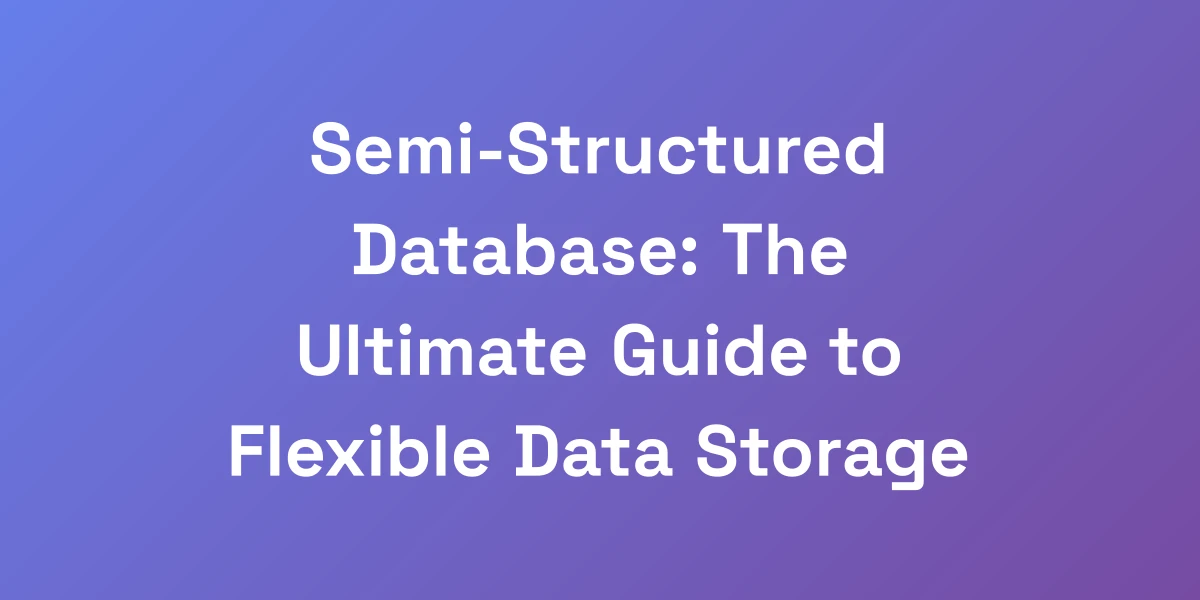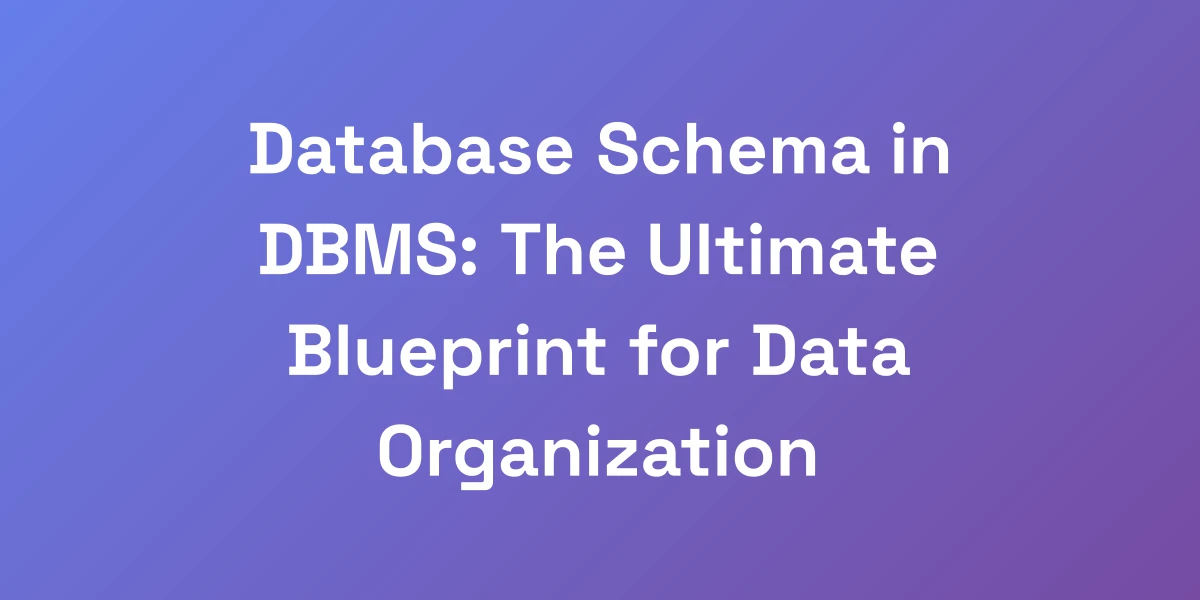
Semi-Structured Data: The Ultimate Guide to Flexible Data Management
Mar 12, 2025 | By [email protected]
Introduction
We’re living in a world where data is the new gold. But what do you do when that data doesn’t fit neatly into a spreadsheet or a traditional database? Semi-structured data is the answer. It’s the middle ground that offers the best of both worlds – the flexibility of unstructured data with the organization of structured formats.
Imagine trying to organize a chaotic garage with no shelves or tools – that’s unstructured data. Now, think of a meticulously arranged library – that’s structured data. Where does semi-structured data fit in? It’s like having adjustable shelves that can adapt to whatever you throw their way. This flexibility is not just a luxury; it’s a necessity in today’s rapidly evolving digital landscape.
But why does this matter? Because businesses are drowning in data that doesn’t fit traditional molds. The challenge isn’t just managing this data; it’s harnessing its potential to drive meaningful insights and strategic decisions. We’re here to show you why semi-structured data is your secret weapon and how mastering it can elevate your data management game to new heights.
Ready to dive deep? Let’s uncover the transformative power of semi-structured data and how it’s reshaping the way we handle information.
Understanding Semi-Structured Data: The Game-Changing Middle Ground
Let’s cut through the noise – semi-structured data is not just another tech buzzword. It’s the linchpin that’s revolutionizing data management across industries. Think about the avalanche of information we deal with daily. It’s not all neatly organized, but it’s not pure chaos either. This is where semi-structured data shines. It bridges the gap between rigid databases and unstructured chaos, offering a versatile framework that businesses can adapt to their unique needs.
The Evolution of Data Structures
Data management has come a long way. From the early days of hierarchical databases to the flexible NoSQL solutions, the journey has been about finding the right balance between structure and flexibility. Semi-structured data emerged as a response to the limitations of traditional databases.
In the past, structured data was king. It worked well for transactional systems where consistency and reliability were paramount. But as businesses started generating more diverse and complex data, the rigid structures couldn’t keep up. Enter semi-structured data, offering a dynamic way to handle diverse data types without sacrificing too much organization.
This evolution is not just academic; it’s a practical shift that reflects the changing needs of modern businesses. Embracing semi-structured data means staying ahead in a global big data market.
Key Characteristics That Define Semi-Structured Data
So, what exactly makes data “semi-structured”? It’s all about the balance. Semi-structured data contains elements of both structured and unstructured data. Think tags, key-value pairs, or any metadata that provides some organizational framework without enforcing strict schemas.
- Flexibility: Unlike structured data, you don’t have to adhere to a rigid schema. This means you can handle varying data formats and types effortlessly.
- Scalability: It’s easier to scale as your data needs grow. Whether you’re dealing with small sets or big data, semi-structured data can adapt without major overhauls.
- Interoperability: It integrates seamlessly with different systems and platforms, making it a versatile choice for diverse business applications.
- Ease of Use: Tools and languages like JSON, XML, and YAML make it straightforward to work with semi-structured data, enhancing productivity and reducing complexity.
Understanding these characteristics is crucial because they unleash a host of opportunities for businesses. From enhancing customer insights to optimizing operations, semi-structured data is a game-changer.
Why Traditional Databases Fall Short
Let’s be honest – traditional databases have their place, but they’re not the silver bullet anymore. They excel in situations where data is uniform and relationships are clear. But what happens when your data is messy, varied, and constantly evolving?
Traditional databases struggle with these scenarios. They require predefined schemas, which means any change in data structure demands a tedious redesign process. This rigidity not only slows down operations but also hinders innovation.
Enter semi-structured data, which thrives in environments where flexibility is key. It doesn’t lock you into one structure, allowing your data to grow and change naturally. This adaptability is why 85% of companies plan to increase investment in semi-structured data technologies – because the traditional approach just doesn’t cut it anymore.
The Business Impact of Flexible Data Models
Why should you care about semi-structured data? Because it directly impacts your bottom line. Flexible data models enable businesses to quickly adapt to market changes, respond to customer needs, and make data-driven decisions with unprecedented agility.
- Enhanced Decision Making: With the ability to integrate diverse data sources, you get a more comprehensive view of your business landscape.
- Increased Efficiency: Streamlined data processes reduce overhead and free up resources for strategic initiatives.
- Competitive Advantage: Companies that leverage flexible data models, such as utilizing competitive pricing data, can innovate faster and respond to market demands more effectively.
- Cost Savings: Avoid the high costs associated with redesigning rigid databases to accommodate new data types and structures.
In essence, semi-structured data empowers businesses to be more responsive, efficient, and competitive in a data-driven world. For instance, integrating Google Maps SEO can leverage semi-structured data to enhance local competitiveness.
Real-World Examples in Action
Let’s ground this in reality. Consider the tech giant Netflix. They handle vast amounts of user data, from viewing habits to search histories. Traditional databases would struggle with the variety and volume of this data. Instead, Netflix uses semi-structured data formats like JSON to manage and analyze information flexibly, enabling personalized recommendations and improving user experience.
Another example is e-commerce giant Amazon. With millions of products and customer interactions, maintaining a rigid schema would be impractical. By utilizing semi-structured data, Amazon can seamlessly integrate diverse data sources, optimize inventory management, and enhance customer satisfaction.
These real-world applications demonstrate how semi-structured data isn’t just a theoretical concept – it’s a proven strategy that drives success in some of the world’s most data-intensive industries.
The Power Trio: Structured vs. Semi-Structured vs. Unstructured Data
Here’s the brutal truth that nobody’s talking about: understanding the difference between these three data types isn’t just academic – it’s the difference between scaling your business and hitting a wall. We’ve seen companies waste millions trying to force-fit their data into the wrong model. Semi-structured data is the perfect balance that most businesses need. It gives you enough structure to maintain order while providing the flexibility to adapt and grow. Let’s break down exactly why this matters and how to leverage each type for maximum impact.
Structured Data: The Traditional Powerhouse
Structured data is the stalwart of data management. It’s highly organized, typically stored in tables with predefined schemas, making it ideal for transactional systems like banking, inventory, and CRM applications.
- Pros:
- Consistency and reliability
- Efficient querying and reporting
- Strong data integrity
- Cons:
- Lack of flexibility
- High maintenance costs for schema changes
- Limited scalability for diverse data types
Structured data excels where data consistency is critical. However, in a dynamic business environment where data needs constantly evolve, it often falls short.
Semi-Structured Data: The Flexible Framework
Semi-structured data bridges the gap between the rigidity of structured data and the chaos of unstructured data. It offers a flexible framework that allows for varying formats and structures, making it ideal for modern applications like web data, IoT, and big data analytics.
- Pros:
- High flexibility and adaptability
- Scalable to handle large and diverse data sets
- Easy to integrate with various data sources
- Cons:
- Less inherent data integrity compared to structured data
- Potentially more complex to query without proper tools
This flexibility makes semi-structured data a powerhouse for businesses looking to harness diverse data types without the constraints of traditional schemas.
Unstructured Data: The Raw Potential
Unstructured data is the wild west of data management. It includes everything from text documents and multimedia files to social media posts and emails. While it’s rich with insights, organizing and extracting value from unstructured data is challenging.
- Pros:
- Contains vast amounts of valuable information
- Highly flexible and adaptable
- Excellent for qualitative analysis
- Cons:
- Difficult to manage and analyze
- Lack of inherent structure hampers efficient querying
- Requires advanced tools for meaningful insights
Unstructured data offers raw potential, but without the right tools and strategies, tapping into its value can be like finding a needle in a haystack.
Choosing the Right Data Model for Your Business
So, how do you decide which data model is right for your business? It boils down to your specific needs, data types, and how you plan to use the data. Here are some actionable tips:
- Assess Your Data Types: Identify the nature and variety of the data you’re dealing with. If you have a mix of structured and unstructured data, semi-structured data might be the way to go.
- Consider Flexibility: Determine how often your data structure might change. For dynamic environments, semi-structured data offers the flexibility required to adapt without major overhauls.
- Evaluate Scalability: Ensure that the data model you choose can scale with your growing data needs. Semi-structured data is inherently scalable, making it a solid choice for expanding businesses.
- Integration Needs: Think about how easily your data can be integrated with existing systems. Semi-structured data formats like JSON and XML are designed for easy integration.
Choosing the right model isn’t a one-size-fits-all decision. It requires a thorough understanding of your business needs and data landscape.
Cost-Benefit Analysis of Each Approach
Understanding the financial implications of your data model choices is crucial. Let’s break down the costs and benefits of structured, semi-structured, and unstructured data approaches:
- Structured Data:
- Benefits: High reliability, efficient querying, strong data integrity.
- Costs: High maintenance for schema changes, limited flexibility, scalability challenges.
- Semi-Structured Data:
- Benefits: Flexibility, scalability, easy integration, cost-effective storage compared to structured data.
- Costs: Potentially more complex querying, less inherent data integrity.
- Unstructured Data:
- Benefits: Vast information potential, high flexibility, excellent for qualitative insights.
- Costs: Difficult to manage and analyze, requires advanced tools, higher storage costs.
When weighing these factors, semi-structured data often emerges as the most cost-effective and versatile choice for businesses seeking both flexibility and structure, including affordable local SEO services.
Mastering Semi-Structured Data Formats
Listen up, because this is where the rubber meets the road. The real money isn’t in just understanding semi-structured data – it’s in knowing exactly how to implement it. We’re talking about formats like JSON, XML, and YAML that are dominating the industry. These aren’t just file formats; they’re the building blocks of modern data architecture.
JSON: The Modern Standard
JSON (JavaScript Object Notation) has become the go-to format for semi-structured data. Its simplicity and readability make it a favorite among developers and businesses alike.
- Advantages:
- Lightweight and easy to parse
- Highly compatible with web technologies
- Flexible structure for diverse data types
- Use Cases:
- APIs and web services
- Configuration files
- Data interchange between systems
JSON’s growth is no surprise – with 41% adoption on web pages by 2024, it’s clear that JSON is here to stay. Its ease of use and compatibility make it a vital tool for managing semi-structured data.
XML: The Enterprise Veteran
XML (eXtensible Markup Language) has been around for decades and remains a staple in enterprise environments. Its robust structure and extensibility make it suitable for complex data management needs.
- Advantages:
- Highly extensible and customizable
- Strong support for metadata
- Widely supported by various systems and platforms
- Use Cases:
- Enterprise data integration
- Document storage and management
- Configuration and communication protocols
Despite being older, XML’s ability to handle complex data structures keeps it relevant, especially in large-scale enterprise applications where semi-structured data is essential.
YAML: The Developer’s Choice
YAML (YAML Ain’t Markup Language) is another popular format known for its human-readable syntax and ease of use. It’s widely used in configuration files and data exchange between languages with different data structures.
- Advantages:
- Readable and easy to write
- Supports complex data structures
- Integrates well with various programming languages
- Use Cases:
- Configuration management
- Data serialization
- Infrastructure as Code (IaC)
YAML’s simplicity and versatility make it a favorite among developers, particularly in environments that prioritize readability and ease of configuration.
NoSQL Databases and Semi-Structured Storage
NoSQL databases are designed to handle a variety of data types, making them perfect for semi-structured data. They offer the scalability and flexibility that traditional SQL databases lack.
- Types of NoSQL Databases:
- Document Stores (e.g., MongoDB)
- Key-Value Stores (e.g., Redis)
- Wide-Column Stores (e.g., Cassandra)
- Graph Databases (e.g., Neo4j)
- Advantages:
- Scalable and distributed architecture
- Flexible data models
- High performance for specific use cases
NoSQL databases like MongoDB allow businesses to store and manage semi-structured data efficiently, providing the flexibility needed to support diverse applications and growing data volumes.
Performance Optimization Techniques
Managing semi-structured data effectively isn’t just about storage; it’s about ensuring optimal performance. Here are some strategies to keep your data operations running smoothly:
- Indexing: Proper indexing strategies can significantly speed up data retrieval processes, making your queries more efficient.
- Data Partitioning: Distribute data across different storage systems or locations to balance load and improve access times.
- Compression: Utilize data compression techniques to reduce storage costs and enhance data transfer speeds.
- Caching: Implement caching mechanisms to store frequently accessed data in faster storage solutions, reducing latency.
- Load Balancing: Distribute incoming data requests evenly across multiple servers to prevent bottlenecks and ensure consistent performance.
By implementing these optimization techniques, businesses can maximize the efficiency and performance of their semi-structured data systems, ensuring they deliver value without sacrificing speed or reliability.
Implementation Strategies That Actually Work
Stop wasting time with theoretical approaches that don’t deliver results. We’re going to give you the exact playbook to implement semi-structured data solutions that actually generate ROI. This isn’t about following trends – it’s about implementing proven strategies like website redesign SEO that scale. The key is understanding how to leverage semi-structured data’s flexibility while maintaining data integrity and performance. Here’s what’s working in 2025.
Data Modeling Best Practices
Effective data modeling is the cornerstone of successful semi-structured data implementation. Here are some best practices to ensure your data models are robust and scalable:
- Understand Your Data: Start by thoroughly understanding the types of data you’ll be handling. Identify key attributes and relationships.
- Use Flexible Schemas: Design schemas that can accommodate changes and additions without requiring major redesigns.
- Normalize Where Necessary: While semi-structured data allows for flexibility, normalizing certain aspects can help maintain data integrity and reduce redundancy.
- Leverage Metadata: Use metadata to add context and improve data discoverability and usability.
- Plan for Scalability: Ensure your data models can scale horizontally and handle increasing data volumes and complexity.
Adhering to these best practices sets a solid foundation for managing semi-structured data effectively, ensuring that your data models support your business goals.
Integration with Existing Systems
Integrating semi-structured data with your existing systems can be a game-changer. Here’s how to do it seamlessly:
- Assess Compatibility: Evaluate how well your current systems can handle semi-structured data formats like JSON or XML. Identify any gaps or compatibility issues.
- Use Middleware: Implement middleware solutions that can bridge the gap between different data types and systems, ensuring smooth data flow.
- Adopt API-First Approach: Develop APIs that facilitate easy data exchange between your systems and semi-structured data sources.
- Ensure Data Consistency: Use data validation and transformation tools to maintain consistency across different systems and formats.
- Implement ETL Processes: Develop robust Extract, Transform, Load (ETL) processes to efficiently handle data integration and ensure high data quality.
Effective integration enables your business to harness the full potential of semi-structured data, enhancing data interoperability and driving more informed decision-making. For link-building strategies, services like FatJoe Backlinks can complement your data initiatives.
Scaling Considerations
As your business grows, so does your data. Scaling your semi-structured data solutions requires strategic planning:
- Distributed Systems: Utilize distributed systems to manage large data volumes and ensure high availability and reliability.
- Horizontal Scaling: Add more servers or nodes to your data infrastructure to handle increased loads without compromising performance.
- Auto-Scaling: Implement auto-scaling mechanisms that dynamically adjust resources based on demand, ensuring optimal performance at all times.
- Data Sharding: Break down your data into smaller, manageable pieces that can be distributed across different storage systems to enhance efficiency.
- Monitoring and Management: Continuously monitor your data infrastructure to identify performance bottlenecks and address them proactively.
Scaling effectively ensures that your semi-structured data solutions can support your business’s growth, maintaining performance and reliability even as data volumes soar.
Security and Compliance
Security isn’t optional – it’s a critical component of any data management strategy. Here’s how to secure your semi-structured data:
- Encryption: Encrypt data both at rest and in transit to protect against unauthorized access.
- Access Controls: Implement robust access controls and authentication mechanisms to ensure only authorized personnel can access sensitive data.
- Data Masking: Use data masking techniques to protect sensitive information, especially in non-production environments.
- Regular Audits: Conduct regular security audits and vulnerability assessments to identify and mitigate potential threats.
- Compliance Frameworks: Adhere to relevant data protection regulations like GDPR, HIPAA, and the Financial Data Transparency Act (FDTA) to ensure compliance and avoid hefty fines.
By implementing these security measures, you safeguard your semi-structured data against breaches and ensure compliance with industry regulations, protecting both your business and your customers. Learn more about semi-structured data in cloud security.
Performance Monitoring and Optimization
Keeping your semi-structured data systems running smoothly requires ongoing performance monitoring and optimization:
- Real-Time Monitoring: Use monitoring tools to track system performance in real-time, identifying issues before they escalate.
- Performance Metrics: Define and track key performance indicators (KPIs) such as data processing speeds, query response times, and system uptime.
- Regular Maintenance: Perform regular maintenance tasks like database tuning, indexing, and cleaning up redundant data to maintain optimal performance.
- Automated Alerts: Set up automated alerts for any performance anomalies, enabling quick responses to potential problems.
- Continuous Improvement: Adopt a culture of continuous improvement, regularly reviewing and refining your data management processes to enhance efficiency and performance.
With vigilant monitoring and proactive optimization, your semi-structured data systems can deliver consistent, high-performance results, ensuring your data management strategies remain effective and reliable.
Future-Proofing Your Data Strategy
Let us be crystal clear: the future belongs to those who can adapt their data strategy on the fly. Semi-structured data isn’t just a trend – it’s the foundation of future-proof architecture. We’re seeing companies that embrace this flexibility outperform their competitors by 3-5x. The next wave of data innovation is coming, and those who understand how to leverage semi-structured data will be perfectly positioned to capitalize on it. Here’s what you need to know to stay ahead.
Emerging Technologies and Trends
The data landscape is evolving rapidly, driven by advancements in technology. Staying ahead means keeping an eye on emerging trends:
- Artificial Intelligence and Machine Learning: AI and ML are transforming how we analyze and interpret data, making semi-structured data more valuable than ever. Check out the top data analytics trends in 2025 for more insights.
- Internet of Things (IoT): The proliferation of IoT devices generates vast amounts of semi-structured data, creating new opportunities for analysis and insights.
- Edge Computing: Processing data closer to its source reduces latency and enhances performance, making it easier to manage and analyze semi-structured data.
- Blockchain: Blockchain technology offers new ways to secure and manage data, including semi-structured data, adding another layer of trust and transparency.
Embracing these technologies will enable your business to harness the full potential of semi-structured data and stay competitive in an ever-changing market.
AI and Machine Learning Integration
AI and Machine Learning are no longer optional add-ons – they’re essential tools for maximizing the value of semi-structured data.
- Enhanced Data Insights: AI algorithms can uncover hidden patterns and trends in semi-structured data, delivering deeper insights than traditional analysis methods.
- Automated Data Processing: Machine learning models can automate data classification, tagging, and transformation tasks, increasing efficiency and accuracy.
- Predictive Analytics: Integrating AI with semi-structured data allows for more accurate predictive models, forecasting trends and behaviors with greater precision. This is a key component of recent research on semi-structured data.
- Natural Language Processing (NLP): NLP can analyze unstructured elements within semi-structured data, such as text fields, enhancing the breadth and depth of data insights.
By integrating AI and ML, your business can unlock new levels of intelligence and automation, making your semi-structured data work harder for you.
Predictive Analytics Capabilities
Predictive analytics leverages historical data to forecast future outcomes, and semi-structured data plays a crucial role in this process.
- Data Enrichment: Combining semi-structured data with structured datasets enriches your predictive models, improving their accuracy and reliability.
- Real-Time Analytics: The flexibility of semi-structured data enables real-time data processing, allowing for timely and actionable predictions.
- Scalability: Predictive analytics tools can scale with your data, handling the increasing volume and variety of semi-structured information without sacrificing performance.
With robust predictive analytics, businesses can anticipate market trends, optimize operations, and make data-driven decisions that propel growth.
Scalability Planning
Future-proofing your data strategy means planning for scalability from the ground up. Here’s how to ensure your semi-structured data solutions can grow with your business:
- Modular Architecture: Design your data systems with a modular approach, allowing you to add or remove components as needed without disrupting overall functionality.
- Cloud Integration: Utilize cloud-based solutions to easily scale your storage and processing capabilities based on demand.
- Automation Tools: Implement automation tools to manage scaling tasks, ensuring seamless and efficient growth without manual intervention.
- Future-Proof Technologies: Adopt technologies that are designed to handle future data demands and integrate with emerging trends, ensuring longevity and adaptability.
By strategically planning for scalability, you ensure that your semi-structured data systems can handle growth seamlessly, maintaining performance and reliability even as data volumes skyrocket.
Future Industry Applications
The potential applications of semi-structured data are vast and continuously expanding. Here’s a glimpse into future industry applications:
- Healthcare: Integrating patient records, lab results, and real-time monitoring data to enhance patient care and streamline operations.
- Finance: Managing diverse financial instruments and transactional data to improve risk assessment and investment strategies.
- Retail: Analyzing customer behavior, inventory data, and sales trends to optimize supply chains and personalize marketing efforts.
- Manufacturing: Utilizing sensor data and production metrics to optimize manufacturing processes and predict maintenance needs.
- Smart Cities: Aggregating data from various sources to improve urban planning, traffic management, and public services.
These applications highlight the transformative potential of semi-structured data, paving the way for innovation and efficiency across multiple sectors.
Conclusion
We’ve journeyed through the landscape of semi-structured data, uncovering its pivotal role in modern data management. From understanding its unique characteristics to mastering its implementation, it’s clear that this flexible data model is a powerhouse for businesses aiming to thrive in a data-driven world.
The key takeaways? Semi-structured data offers the best of both worlds – the organization of structured data with the adaptability of unstructured formats. It empowers businesses to integrate diverse data sources, enhance decision-making, and scale efficiently without breaking the bank.
But don’t just take our word for it. With 80% of businesses already utilizing semi-structured data for advanced analytics and 85% planning to ramp up their investments, the momentum is undeniable. The future belongs to those who can harness this flexibility to drive innovation and sustain growth.
Ready to revolutionize your data management strategy? Start by evaluating your current data landscape and consider integrating semi-structured data solutions. Embrace the flexibility, leverage the tools, and watch your business soar.
What steps will you take today to unlock the potential of semi-structured data? Share your thoughts and experiences below, and let’s continue the conversation on building a data-driven future.








